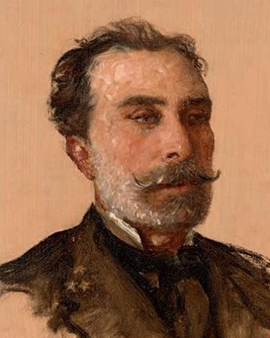Charles Landelle was considered a specialist when it came to authentically depicting individual figures. The French painter was born in 1821. His father got a job as a caliographer and musician in Paris (Tuileries) and moved with the whole family. Landelle had a unique opportunity to enroll in the École des Beaux-Arts (State School of Fine Arts) in Paris. There he received lessons from the French history painter of academic realism, Paul Delaroche. Under his teacher, Charles Landelle learned to handle the brush accurately and to sharpen his powers of observation. The budding painter was not only talented, but also very ambitious. In 1841, Landelle made his exhibition debut. Self-portraits and religious and historical paintings were exhibited, revealing a soft and sensitive aura.
Charles Landelle married twice. The second wife, Anaïs Beauvais, was also a painter and was a student of Lazarus Wihl, Pauline Carolus-Duran and Jean-Jacques Henner. Landelle even painted religious pictures. Parisian churches such as St. Roch, St. Germain l'Auxerrois and St. Sulpice were among his clients. France was not the only pivot of his artistic being. In 1865 Landelle set off on journeys to the Middle East and North Africa. He traveled through Morocco, Algeria and Egypt. He continued thousands of kilometers up the Nile in tow with the Egyptologist Auguste Mariette. During this period of his life he created many popular works. The painter was also a representative of Orientalism. The opening of the Suez Canal in 1869 had already increased the interest of Europeans in the Middle East. More and more artists drew or painted landscapes, vedute, monuments, everyday life and costumes in the dominion of the Ottoman Empire. Landelle was also obsessed with this current.
He loved to play with keywords like sensuality and decadence. Landelle made it his mission to provide the bourgeois audience with sensual and picturesque scenes. The artist skillfully incorporated stylistic elements of neighboring cultures into his works. This was often done in a romantic manner. The portraits 'Rebekah' or the 'Jewish Woman from Tangier' depict oriental women who reflect seductive beauty. With the painting 'Nymph Ismene', the painter had created a veritable myth. Some of his works point to mythological models. The oil painting 'The Storm' may well have provided plenty to talk about. The painting shows a naked woman, who stretches her arm threateningly forward. Pure determination can be read in her gaze. Like a rock in the fire, the unknown person stands surrounded by roaring water and approaching birds. Charles Landelle knew how to make breathtaking works of art out of the pictures until his death.
×





.jpg)
.jpg)
.jpg)
.jpg)
.jpg)
.jpg)
.jpg)
.jpg)
.jpg)
.jpg)
.jpg)
.jpg)
_-_(MeisterDrucke-1021521).jpg)
_-_(MeisterDrucke-1021521).jpg)
 - (MeisterDrucke-81946).jpg)
 - (MeisterDrucke-81946).jpg)
.jpg)
.jpg)
.jpg)
.jpg)
.jpg)
.jpg)
.jpg)
.jpg)
.jpg)
.jpg)
.jpg)
.jpg)
.jpg)
.jpg)
_French_poet_in_1854_Painting_by_Charles_-_(MeisterDrucke-988210).jpg)
_French_poet_in_1854_Painting_by_Charles_-_(MeisterDrucke-988210).jpg)
_French_poet_Painting_by_Charles_Landell_-_(MeisterDrucke-971067).jpg)
_French_poet_Painting_by_Charles_Landell_-_(MeisterDrucke-971067).jpg)
.jpg)
.jpg)
 1854 (pastel on paper) - (MeisterDrucke-106067).jpg)
 1854 (pastel on paper) - (MeisterDrucke-106067).jpg)
.jpg)
.jpg)
.jpg)
.jpg)
.jpg)
.jpg)
.jpg)
.jpg)
.jpg)
.jpg)






